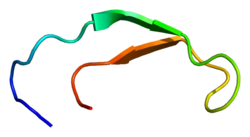Hepcidin
| Hepcidin | |||||||||
|---|---|---|---|---|---|---|---|---|---|

Solution structure of hepcidin-25.
|
|||||||||
| Identifiers | |||||||||
| Symbol | Hepcidin | ||||||||
| Pfam | PF06446 | ||||||||
| InterPro | IPR010500 | ||||||||
| SCOP | 1m4f | ||||||||
| SUPERFAMILY | 1m4f | ||||||||
| OPM superfamily | 162 | ||||||||
| OPM protein | 1m4e | ||||||||
|
|||||||||
| Available protein structures: | |
|---|---|
| Pfam | structures |
| PDB | RCSB PDB; PDBe; PDBj |
| PDBsum | structure summary |
| hepcidin antimicrobial peptide | |
|---|---|
| Identifiers | |
| Symbol | HAMP |
| Entrez | 57817 |
| HUGO | 15598 |
| OMIM | 606464 |
| RefSeq | NM_021175 |
| UniProt | P81172 |
| Other data | |
| Locus | Chr. 19 q13.1 |
n/a
n/a
n/a
n/a
n/a
Hepcidin is a protein that in humans is encoded by the HAMP gene. Hepcidin is a key regulator of the entry of iron into the circulation in mammals.
In states in which the hepcidin level is abnormally high such as inflammation, serum iron falls due to iron trapping within macrophages and liver cells and decreased gut iron absorption. This typically leads to anemia due to an inadequate amount of serum iron being available for developing red cells. When the hepcidin level is abnormally low such as in hemochromatosis, iron overload occurs due to increased ferroportin mediated iron efflux from storage and increased gut iron absorption.
In lab mice, hepcidin has been found to have anti-inflammatory properties. This is a negative feedback: it reduces the inflammation which caused the elevated hepcidin level.
...
Wikipedia


